360° View - Evercool
Magic Cooler MAG01-CA Heatsink
Information on
Frostytech's test methodology is available
here. | |
|
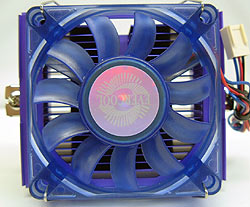 |
The
Heatsink Fan:
The 15x70x70mm fan spins at 3500RPM and moves
about 27CFM according to official data. There is no fan guard, or
illuminating LEDs for the translucent blue impeller for that matter.
The fan draws power from a standard 3-pin motherboard fan header that
supports RPM monitoring. |
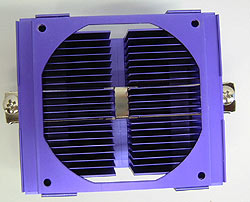 |
Heatsink Top:
An extruded aluminum fan
shroud supports the 70mm fan just above the tips of
the fins, creating a 4mm plenum. It also provides a platform for
the socket 478 mounting hardware. A large 7mm wide cross-cut goes down the
center of the heatsink. This space is for the K7 mounting clip. The K8 clip
fits in between the fins, with a small tab in the cut to
prevent lateral movement. |
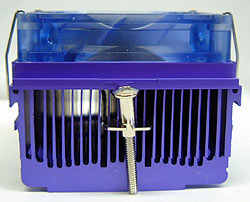 |
Heatsink Side A:
The K8 mounting clip is very stiff, and screws directly into the back plate. The Evercool MAG01-CA heatsink
fins average 30mm high, 1mm thick, and 38mm wide. Fin spacing
is kept at a very typical 2mm. The extrusion pattern includes a recess for
the socket cam arm of sockets A and 370 processors. The aluminum base
is 8.5mm thick, but doesn't extend the full length of the heatsink.
|
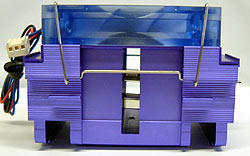 |
Heatsink Side B:
Wire clips hold the fan in place, screw holes
are set into the shroud so larger fans can easily be added
if the user has appropriately sized screws at hand. Two very deep 10mm
wide cuts are made into the base of the heatsink either side
of the copper insert. These cuts are 12mm deep, and completely cut
through the extrusion's base. We can only assume the idea is to get airflow moving down and into
the area around the CPU socket. Such a design choice certainly affects the
ability of the heatsink to conduct heat towards its outer edges. |
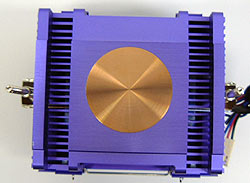 |
Heatsink Base:
The 10mm wide cuts in the base reveal the underside of
the extrusion's fins which are
certainly going to loose some effectiveness in the heat transfer department. The copper
insert is 35mm in diameter and has a surface finish of approximately 16 microinches which is very good. The surface flatness of the copper is good, but the surrounding aluminum is not exactly flush with
it. |


